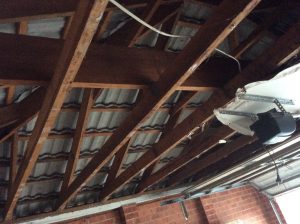A common defect that we find during our inspections is garage ceiling plaster sagging and, in many cases, it has collapsed. 
As the garage is not a habitable room, the roof cavity above is not required to have insulation installed. People view insulation as a product that is only installed to help with heating and cooling an area. Up to 35% of heat is lost through the roof*.
What people do not know is that insulation also acts as an absorbent and absorbs condensation from the air inside the roof cavity. When you get areas like the garage roof cavity with none installed, the ceiling plaster begins to absorb the condensation.
In doing so, the ceiling plaster will then start to breakdown and come away from the glue and screws holding it in place. Eventually gravity takes over and the ceiling collapses.
I have been called out to several cases where cars parked inside have been damaged and some near misses with people being inside the garage at the time.
Builders are continuing to install plaster in the garages, I have come across insurance companies rectifying the issue by reinstalled ceiling plaster AGAIN, not solving the problem at all.
There are simple solutions to this problem –
If you are building a new home or renovating.
- Have the garage roof insulated like the rest of the roof.
- Have cement sheeting installed instead of ceiling plaster.
If you have notice the ceiling sag in an established home.
- Have insulation installed inside cavity (If possible). Then engage a plasterer to securely fix plaster back in place.
- Have a carpenter install batons across the face of the ceiling plaster to secure it to the joists above. Then paint them white so they do not stand out. This is a clever fix I came across in a house I inspected last year. A tip I have passed on to a countless new home buyers.
This is the same for houses that have no insulation in the roof cavity throughout or the insulation has broken down and deteriorated. It may not collapse in the house but it will sag and cost more to fix than to install new insulation. It is best to have your roof cavity assessed for any evidence of the above defects.

